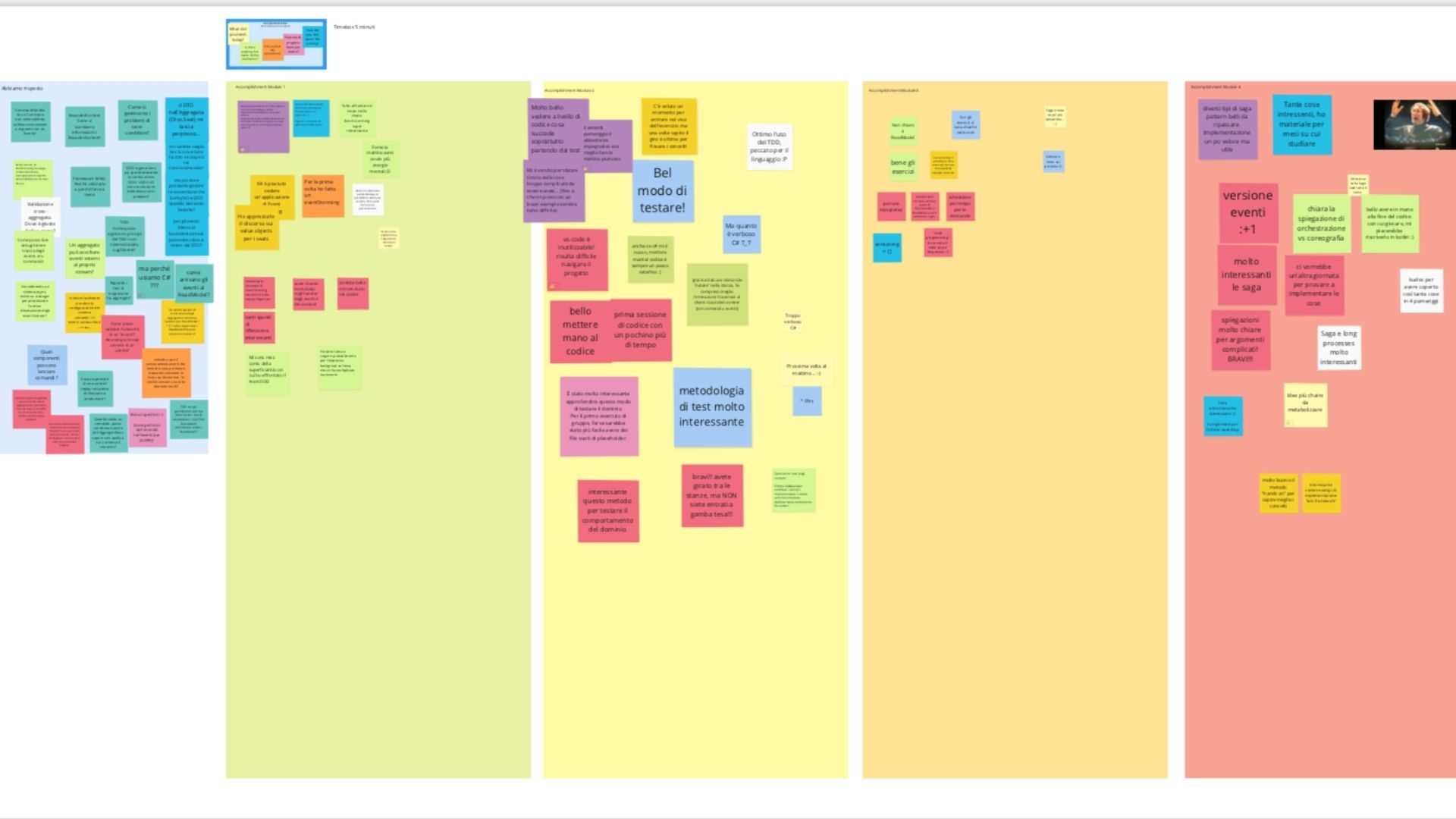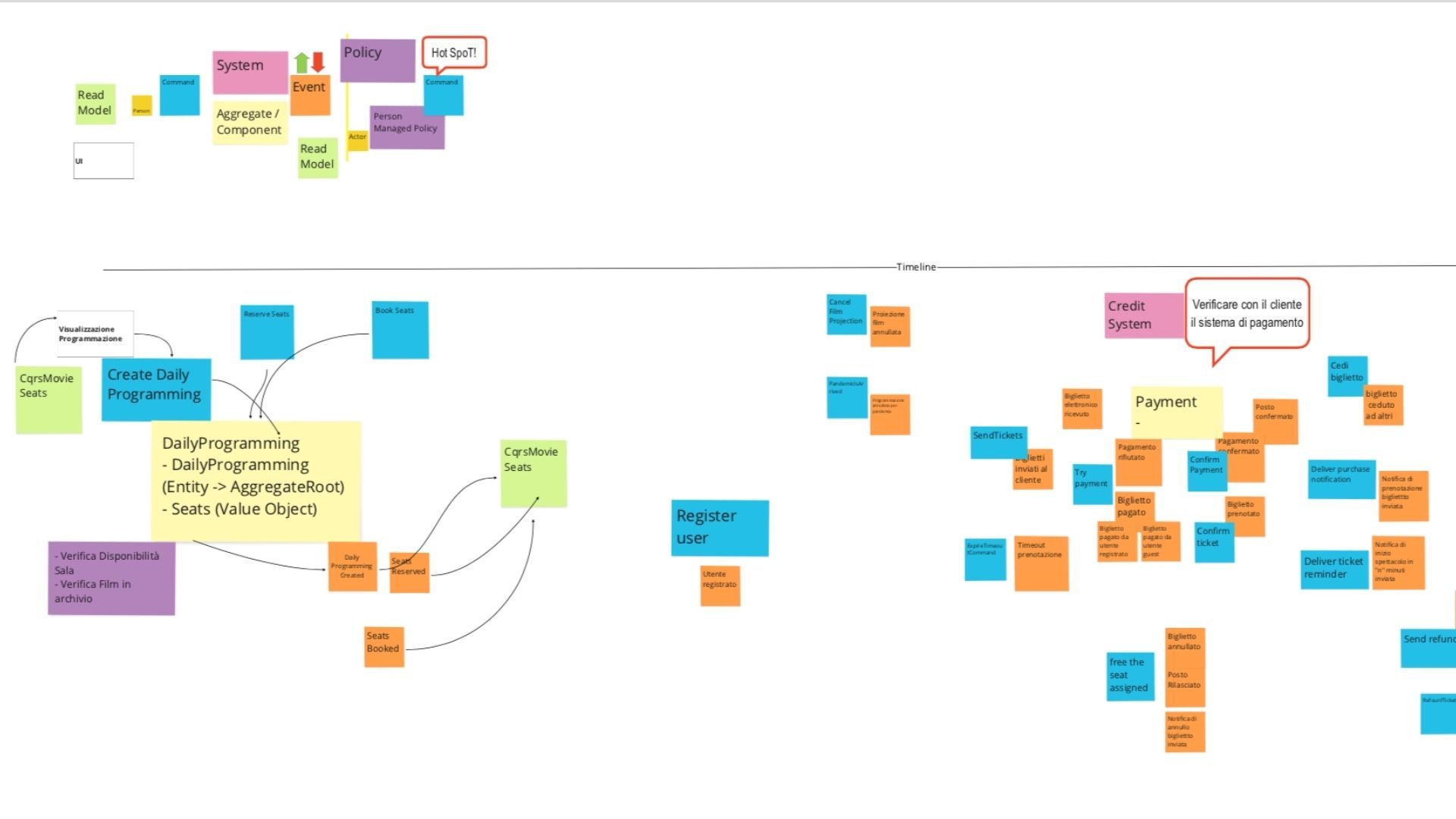On the 10th of December 2020 I had the pleasure, together with Alberto Acerbis, of teaching the second edition of our DDD and CQRS+ES course through the prolific Avanscoperta, a company headed by Alberto Brandolini.
The course was designed to be held in person and over two full days, but for the contingent reasons of 2020, we reconfigured it to be a remote one. This post aims to tell the choices we made and share my personal lessons learned from these two fantastic experiences.

Half days, no more
The first important change we made was to split the course into four half days, because, both for personal experiences and for those shared by Avanscoperta, spending an entire day in front of the monitor, following thoughtfully these heavy topics, would have been too demanding for the applicants. What I found, as a participant in courses in Italy and abroad, is that between the concentration required from a day in person and a half day in remote there is an abysmal difference. Incredibly, spending four hours following the speaker, perhaps only seeing his slides, requires a non-trivial effort. It is enough to forget to silence the mobile phone, close the company chat or the e-mail client and you can be immediately distracted and lose part of the explanation. Moreover, being alone in my home office following the course, if the teacher does not often vary the way of conducting his lesson (i.e.: interruptions, questions), it happens to get lost with other thoughts and “wake up” five minutes later.
The half days allow you to avoid taking away too much continuous time from work and think about the concepts seen during the course. We have also organized the days before and after the weekend (i.e.: Thursday, Friday, Monday, and Tuesday) to allow people to think more calmly on the first two days and have a more profitable comparison the following Monday.
The last trick adopted was to use the morning instead of the afternoon; in the first edition we had opted for the afternoon, but the feedbacks were unanimous in highlighting that they would have preferred the morning for the availability of “mental resources”.
Pause, pause, pause
Unlike a live course, as previously written, the remote one requires much more concentration, therefore it is essential to increase the number of breaks even if short; the advice is at least five minutes every hour plus a longer break (a quarter of an hour is enough) at mid-morning. But be careful that just taking a break is not optimal, the teacher should try to make the participants get up from their chairs and move a little. The mere act of getting up increases the assimilation of oxygen which helps us to think better and to “wake up” a little. A course, which I really enjoyed, which addresses these issues by providing multiple techniques to make learning more effective, is “Training from the BACK of the room”.
Be on time and respect of deadlines
Another important aspect of a remote course is punctuality and enforcing deadlines. If small delays can be managed and absorbed in a live course without too many problems, it is not possible to have the same result remotely, therefore it becomes essential that they are programmed in advance. For the sake of time, sharing the screen with a timer like, for example, BigTimer is very useful.
Time to reply
One aspect on which the organizers of Avanscoperta have, rightly, made us aware of is giving participants more time to answer questions. Remotely, when you ask “is everything clear? Are there any questions?” you cannot wait three seconds and then continue with the following topic. It is important to provide more time, because, trivially, in addition to taking into account the reactivation time of the microphone, compared to a live class, there is no overall view of the people in the room (Zoom, for example, shows at once only the first five or six participants) and therefore it is not possible to understand “on the fly” if someone is reflecting to ask the question, meaning he is hesitant, and we can therefore help him to overcome the uncertainty or simply it is all clear and you can continue with the next topic.

Socializing
The socialization phase during a remote course is, in my opinion, a pain point. A part that I think is extremely valuable, is getting to know other professionals with whom you can discuss on the most varied topics or, simply, meet interesting people (and I can guarantee that in the courses organized by Avanscoperta you never remain dry-mouthed in this respect)..
Consequently, the remote course limits interactions between people, and, in my experience, you lose some of that involvement that is generated by being surrounded by other people active in a discussion. It is even more important then, at the beginning of the first day, to do a round of introductions to break the ice among the participants.
A solution that has mitigated this aspect was the use of breakout rooms to do group exercises, working together and forced confrontation allowed to break down the barrier and you could feel the change already after the first session.
Do not underestimate the tool
The video conference tool has a decisive role for the success of the course, it must be simple to use and immediate to be able to intervene with a question. Another important aspect is the management of work groups, participants must be able to request support easily, it must be straightforward to send messages to all groups for general communications and to be able to enter and exit them quickly.
Higher stress level for the trainer
Not seeing all the people in the classroom at the same time and a partial body language (only the face), does not allow to understand if someone has difficulties or doubts and it follows that it is much more difficult to understand if it is necessary to dwell more on the topic, repeat a concept or simply start a discussion (which always bring a lot of value).
Let’s add that, for the same reasons mentioned above, the stress for the trainer is much higher. On this side of the “barricade” you need much more concentration and recovering from an error can be more difficult (i.e.: going long on the scheduled times or realizing that you have given a non-exhaustive answer).
Finally, for those wishing to find out the details of the course, here is the links to the presentation video and a talk done this year on one of the topics covered in it.